
Review
Valhalla review – the free God of War expansion is absolute madness
by Domagoj Belancic

Extra content in some of my favourite games has transformed me from roguelike hater to fan. Well, almost. My relationship with the genre is… complicated.
Roguelike modes in AAA games are a surprising trend in the still young gaming year 2024. Strictly speaking, this trend started last year. At the Game Awards, developer studio Sony Santa Monica announced an expansion for God of War: Ragnarok out of the blue. Even more surprising – the Valhalla expansion is a free roguelike mode.
As excited as I was at first about new, free God of War content, I was disappointed after the genre reveal. I’ve never been able to get down with roguelikes. Even absolute genre highlights like Hades failed to inspire me for long.
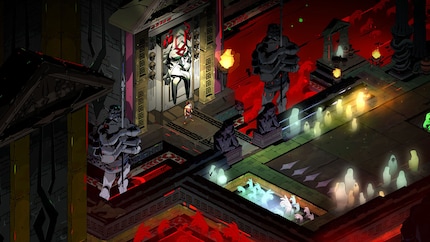
Roguelikes feel like a waste of time. I love games where I make steady progress, where I know I’m guaranteed to unlock more with every hour I spend playing. Roguelikes lack this security. They’re often frustrating, combining high difficulty with slow game progress.
Despite my aversion, I’ve fallen in love with three roguelikes in the past few months.
To me, Valhalla is one of the biggest surprises of my gaming career. Never in my life would I have thought that I’d ever have so much fun in a roguelike. And this despite the fact that it contains all the typical roguelike elements that I don’t really like.
The gameplay loop consists of fighting, upgrading, dying, repeat. Your goal is to finish a mysterious challenge in Valhalla with Kratos. On the way, I have to brutally mow down countless monsters in random arenas. Battles themselves aren’t very different from the main game. The numerous modifiers and upgrades, which I can unlock either temporarily or permanently, bring a breath of fresh air.
However, the familiar Melee gameplay isn’t the main reason for my enthusiasm. I love how the game marries the plot with its new roguelike mode. The Greek god of war must confront the atrocities he committed in his old homeland in the Nordic battle arenas of Valhalla. He literally fights with the demons of his past, losing again and again. It’s not just mindless killing and being killed, but excellent interactive storytelling.
Even if I die during a run, the story continues – I’m not wasting any time. What’s more, repeated death and resurrection are part of the story. Thing is, Hades also has a great story, elegantly combined with the roguelike structure as well. Nevertheless, the game was never able to convince me. But why?
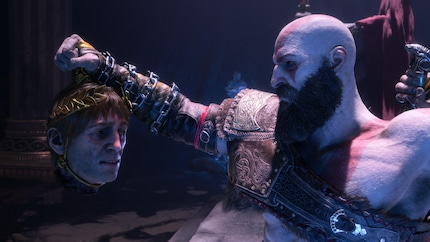
Suddenly, the scales fall from my eyes. Valhalla grabs me exactly because of what it is. It’s «only» an expansion and not a stand-alone game, building on existing story elements from the God of War universe and combining them with the fresh roguelike game structure. In contrast to Hades, I immediately feel at home. It’s all very familiar, yet somehow different. I’ve already spent countless hours playing with these characters, and I look forward to revisiting them in a new context, getting to know them better. The roguelike structure isn’t the main attraction, but a means to an end to explore one of my favourite games from a new perspective.
My second roguelike love came with the PS5 remaster of The Last of Us Part II, a few weeks after Valhalla. In addition to improved graphics, the rerelease offers a new game mode called No Return. Here, I slaughter my way through a total of six random levels from the main game in typical roguelike style. If I die, I lose all my temporarily earned upgrades and weapons and have to start all over again.
While Valhalla impresses with its fusion of plot and roguelike structure, there’s absolutely no background story in No Return. I play a fictional scenario in which the layered characters from the main game degenerate into soulless action figures. Despite this stark contrast, the mode grabs me. Or is it even because of the stark contrast? It’s cool to mindlessly hand out headshots with Ellie, Joel, Abby or Lev without worrying about the consequences of their actions. The game doesn’t take itself seriously here and just lets me have fun.
In contrast to Valhalla, the gameplay in No Return is very different from the main game. This is mainly down to the crazy gameplay modifiers activated in some levels. I use them to fight transparent opponents, dodging randomly generated Molotov rain or setting enemies on fire with my punches. Unthinkable in the deadly serious and realistic main game.
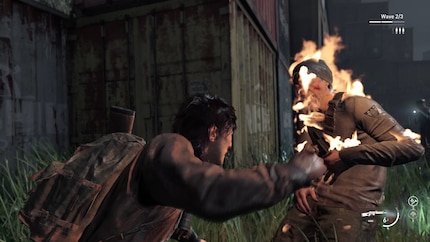
Despite the different approach compared to Valhalla, I come to a similar conclusion. No Return shines because it’s «only» an extension. The new game mode succeeds because it allows me to experience one of my favourite games from a completely new, surreal perspective. The plot and gameplay of the main game aren’t continued, but completely turned on their head. My ideas and expectations of a Last of Us game climb to absurd new heights. I’m simultaneously confused, surprised and extremely entertained.
Nintendo is also jumping on the roguelike bandwagon, releasing an expansion for the colour shooter Splatoon 3 on 22 February. I played the game for a few hours at a preview event and I’m sure it’ll be my next big roguelike love. In Side Order, I fight my way through a 30-storey tower full of mysterious fish and octopus enemies. The same applies here – fight, die, upgrade, repeat.
Conceptually, the expansion is a mixture of Valhalla and No Return. In other words, the absurd story of the main Splatoon games is combined with the roguelike structure in a clever way. The gameplay takes me by surprise with twists that would be impossible in the main game.
On the surface, Side Order looks familiar. I still spend most of my time shooting paint. The reason why the expansion convinced me in the short time I played it is the amazingly extensive and flexible upgrade system. I receive equippable colour chips for each floor I conquer. These have an influence on my attributes such as attack power, range and mobility.
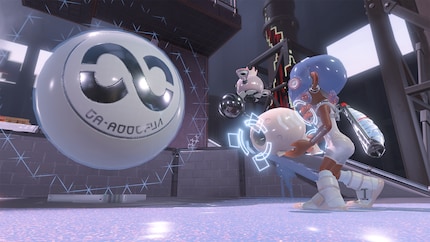
If you’re familiar with the weapons from Splatoon 3, you can use the chips to enhance their strengths or eliminate their drawbacks. This allows me to convert a slow and precise sniper rifle into a fast weapon with a large area of effect. Such completely overpowered builds would be unthinkable in the main game or in competitive multiplayer. There, weapons and attacks are meticulously balanced so that different playing styles remain in harmony. I’d never, ever be allowed to compete against other players with my sniper shotgun build. In roguelike mode, I can let off steam regardless of losses and test the limits of Splatoon gameplay.
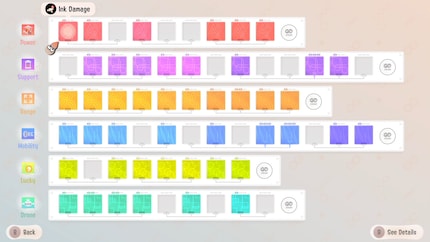
My fascination with Side Order can also be traced back to the fact it’s only an expansion and not a stand-alone game. I’m familiar with the chaotic colour shooter gameplay and can really go wild here. I can also learn more about the crazy background lore of the Splatoon world. Glorious.
Valhalla as well as No Return and Side Order offer classic roguelike fare. I fight my way through randomly generated battle arenas, collecting temporary and permanent upgrades. If I die, I have to start all over again and can only bring the upgrades I’ve permanently earned with me.
These three additional game modes offer exactly what I don’t really like about roguelike games. And yet, the expansions still inspire me. They don’t feel like a waste of time by any means. This is mainly down to the fact that they’re «only» expansions and not stand-alone games. The roguelike structure isn’t the main attraction, but merely a means for me to enjoy these excellent games from a new perspective.
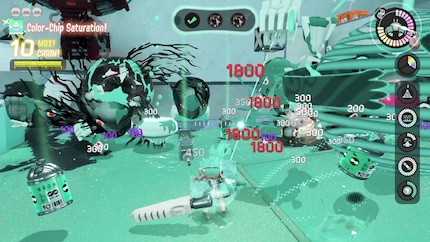
All three games approach their original stories very differently. While Valhalla and Side Order cleverly combine their story with the roguelike structure, No Return dispenses with any context. I enjoy both options. With the first approach, I get to know the game world and its characters better. With the second, I experience an otherwise ultra-serious and depressing game from a completely new, light-hearted perspective. Apart from the roguelike structure, the three games also differ in terms of gameplay innovations. Valhalla is pretty similar to the main game, No Return shocks with crazy modifiers and Side Order captivates with an amazingly complex upgrade system.
Never in my life did I think I’d ever have so much fun with roguelikes. But my relationship with the genre as a whole remains complicated. I find roguelikes particularly exciting as a vehicle for new gaming experiences in environments I’m already familiar with. As a main attraction in its own right, the idea still doesn’t convince me.
Even though I was able to approach the genre, I’m not eagerly awaiting the release of Hades II regardless. Instead, I’m counting the days until Side Order is released and hope that many more developer studios will jump on the trend and expand their games with entertaining roguelike modes.
My love of video games was unleashed at the tender age of five by the original Gameboy. Over the years, it's grown in leaps and bounds.